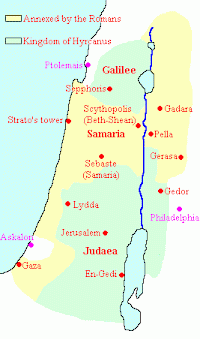Pompey's Siege of Jerusalem
Roman-Jewish Wars: name of several military engagements between the Roman Republic (later: Empire) and various groups of Jews between 63 BCE and 136 CE.
Pompey's Siege of Jerusalem

The Roman politician Gnaeus Pompeius Magnus (106-48 BCE), better known as Pompey, was one of the greatest generals of his age. In the seventies, he had pacified Hispania, and on his return to Italy, he had put an end to the slave revolt led by Spartacus. In 67, the Senate had ordered him to make an end to the menace of the pirates of Cilicia (the south of modern Turkey): in order to do this, he was given an extraordinary command that was to last three years. In three months, Pompey forced the pirates to surrender, and he decided to use the remaining thirty-three months to pacify the eastern Mediterranean.
There were several wars in which he could intervene. The kingdoms of Pontus (northern Turkey) and Armenia had joined forces against the Romans; and although the Roman commander Lucullus had been successful, he had not brought the war to an end. On Crete and in Syria, there was no recognized authority. And the Jewish queen Alexandra-Salome had died, after which their sons Hyrcanus and Aristobulus had started a bloody civil war, which was ruining Judaea. To an ambitious man like Pompey, the situation offered opportunities he could not afford to miss. He invaded and annexed Pontus in 66, went on to attack the Armenians, added several hitherto unknown Caucasian tribes to his battle roll of victories (65), almost reached the shores of the Caspian Sea, and then turned his attention to Syria, which he annexed in 64.
Meanwhile, the conflict between the two Jewish princes had escalated. The Pharisees sided with Hyrcanus, the Sadducees with Aristobulus. During the festival of Passover of 63, Aristobulus and the Sadducees were besieged in the Temple of Jerusalem by Hyrcanus and his ally, the Arab king Aretas of Petra. However, Aristobulus managed to send an envoy to Pompey's representative in Syria, Marcus Aemilius Scaurus. The Jewish leader promised 8,000 kg of silver, an offer that Aemilius could not refuse: he immediately ordered Aretas to leave. When Pompey arrived on the scene, he received an even larger present: Aristobulus sent him a golden vine of no less than 800 kg, which the Roman commander forwarded to the temple of Jupiter in Rome.
Having gained Pompey's favor, Aristobulus was safe from his brother. Unfortunately, he had made a mistake. He sent an envoy to Pompey, asking him to punish Aemilius, who - according to Aristobulus - had extorted from him 8,000 kg of silver. Pompey decided to come to Jerusalem to see for himself what was going on; there, he sided with Hyrcanus and had Aristobulus arrested.
Hyrcanus' followers allowed Pompey to enter the lower town of Jerusalem, but Aristobulus' adherents, the Sadducees, still occupied the Temple. In the west, there was a bridge between the Temple and the city, but this had been destroyed; in the south and east, there were deep valleys. Therefore, Pompey decided to attack from the north. (They only worked on the siege dam on the sabbaths, because the Jews could defend themselves on that days, but were not allowed to attack.) When the siege dam was completed, towers were rolled towards the wall of the Temple. Catapults kept up a continuous pressure by hurling heavy stones; a battering ram broke the wall, and Pompey's soldiers entered the Temple terrace, where they started to kill the defenders. Many Jewish soldiers committed suicide, because they did want to see the profanation of the sanctuary (June/July 63).
When the Romans controlled the Temple, Pompey and his officers entered the Holy of Holies - according to the Jews a blasphemous act, because only the high priest was allowed to enter this room. The conqueror saw the Menorah, the treasure and all sacred vessels. His soldiers seem to have sacrificed to their standards.note Next day, he ordered the cleansing of the Temple, and he appointed Hyrcanus as high priest.

Meanwhile, Marcus Aemilius Scaurus attacked Aretas of Petra, but allowed himself to be bribed for another 6,000 kg of silver. Soon afterwards, he was killed (an event mentioned in one of the Dead Sea scrolls). At that moment, Pompey had already left Judaea. He returned to Rome, where he had become the most influential politician of his age. He took many prisoners with him, who were later released and settled in the large section of Rome beyond the river Tiber.note
Large parts of the Jewish kingdom - essentially the most hellenized regions - were annexed by the Romans. From now on, Judaea and Galilee were just one of Rome's client kingdoms in the east.
Hyrcanus was high priest and received the title ethnarch ('national leader'). His position was safe, although Aristobulus tried to come back from Rome in 57-55 BCE. In 49, however, there appeared a dark cloud on the horizon: a civil war broke out in the Roman Empire. Pompey was defeated by Julius Caesar, who pursued his enemy to the East. Caesar chose to co-operate with Hyrcanus, but appointed the latter's courtier Antipater epitropos ('regent'). When war broke out with the Parthians, Hyrcanus was taken prisoner (40 BCE). Antipater's son Herod managed to bring him home, but Hyrcanus was no longer high priest and Herod, who became king, had him executed in 31 BCE.